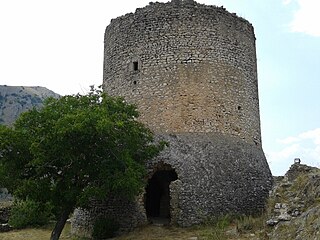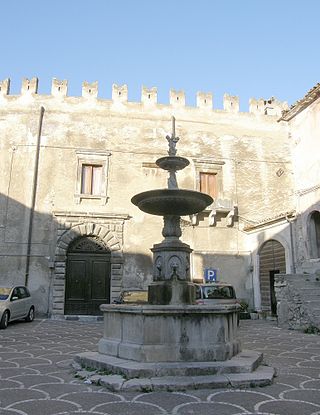
Abruzzo, historically known as Abruzzi, is a region of Southern Italy with an area of 10,763 square km and a population of 1.3 million. It is divided into four provinces: L'Aquila, Teramo, Pescara, and Chieti. Its western border lies 80 km (50 mi) east of Rome. Abruzzo borders the region of Marche to the north, Lazio to the west and north-west, Molise to the south and the Adriatic Sea to the east. Geographically, Abruzzo is divided into a mountainous area in the west, which includes the highest massifs of the Apennines, such as the Gran Sasso d'Italia and the Maiella, and a coastal area in the east with beaches on the Adriatic Sea.

The province of Pescara is a province in the Abruzzo region of Italy. Its capital is the city of Pescara, which has a population of 119,483 inhabitants. As of 2017, it has a total population of 319,936 inhabitants over an area of 1,230.33 square kilometres (475.03 sq mi). The provincial president is Antonio Zaffiri and the province contains 46 comuni.

Avezzano is a city in the Abruzzo region, province of L'Aquila, Italy. It is the second most populous municipality in the province and the sixth in the region. It is the main commercial, industrial and agricultural centre of the Marsica area, with important high-tech industries and the Fucino Space Centre.

Pescasseroli is a town and comune in the province of L'Aquila, in Southern Abruzzo, central Italy.

Penne is an Italian town in the province of Pescara, in the Abruzzo region, in mid-southern Italy. According to the last census in 2014 the population was 12,451. It is one of I Borghi più belli d'Italia.

Campo di Giove is a town and comune in the province of L'Aquila in the Abruzzo region of central Italy. Its territory is included in the Majella National Park. Located at the foot of the southwestern slope of the Majella, it is a holiday resort in summer and winter, thanks to the presence of a ski station. In English, its name means 'Campus Jovis'.

Goriano Sicoli is a comune and town in the Province of L'Aquila in the Abruzzo region of Italy.

Alanno is a comune and town in the province of Pescara in the Abruzzo region of Italy.
Sant'Eufemia a Maiella is a town and comune in the province of Pescara, Abruzzo, central Italy. It is located in the Maiella National Park in a valley enclosed by the western slopes of the Majella massif, and the northeastern slopes of the Morrone group.

Tocco da Casauria is a comune and town in the Province of Pescara in the Abruzzo region of Southern Italy.

The Duchy of Alvito was a fiefdom of the Kingdom of Naples, in southern Italy.

Tourism in Abruzzo has become one of the most prosperous sectors in the economy of Abruzzo, and in recent years has seen a remarkable growth attracting numerous tourists from Italy and Europe. According to statistics, in 2021 arrivals totaled 1,330,887. A total of 5,197,765 arrivals were tourists, a figure that puts the region seventeenth among the Italian regions for numbers of tourists per year. A moderate support to tourism is also given to the Abruzzo Airport with many low cost and charter flights connecting the entire region with the rest of Europe.

The Castle of San Pio delle Camere is a medieval castle in San Pio delle Camere, province of L'Aquila, Abruzzo, southern Italy.

Castello di Ortona dei Marsi is a Middle Ages castle in Ortona dei Marsi, Province of L'Aquila (Abruzzo).

Castello De Sanctis is a Middle Ages castle in Roccacasale, Province of L'Aquila (Abruzzo).

Castello Mediceo is a Middle Ages castle in Bussi sul Tirino, Province of Pescara (Abruzzo).

Castello ducale Cantelmo is a Middle Ages castle in Popoli Terme, Province of Pescara (Abruzzo).

Taverna Ducale di Popoli is an art museum in Popoli Terme, Abruzzo.
Don Carlo II di Tocco Cantelmo Stuart, or Carlo di Tocco for short, was an 18th/19th-century Italian noble, serving as the Prince of Montemiletto and the titular Prince of Achaea, among other titles, from the death of his father Restaino di Tocco Cantelmo Stuart in 1796 to his own death in 1823. In addition to holding various fiefs throughout Italy, Carlo also rose to prominent positions within the Kingdom of Naples and its successor state, the Kingdom of the Two Sicilies. In 1808, he came one of the earliest knights of the Royal Order of the Two-Sicilies and from 1821 to 1823, he served as a Councillor of State in the Kingdom of the Two Sicilies.






















